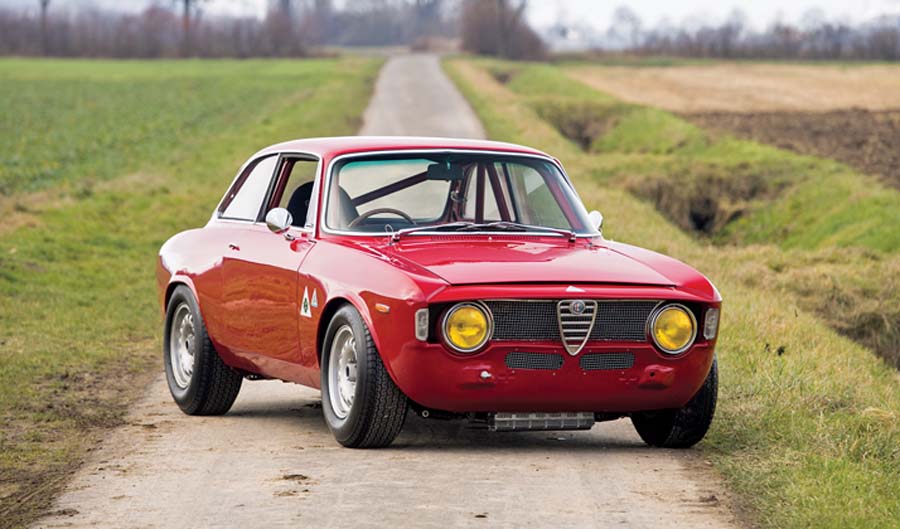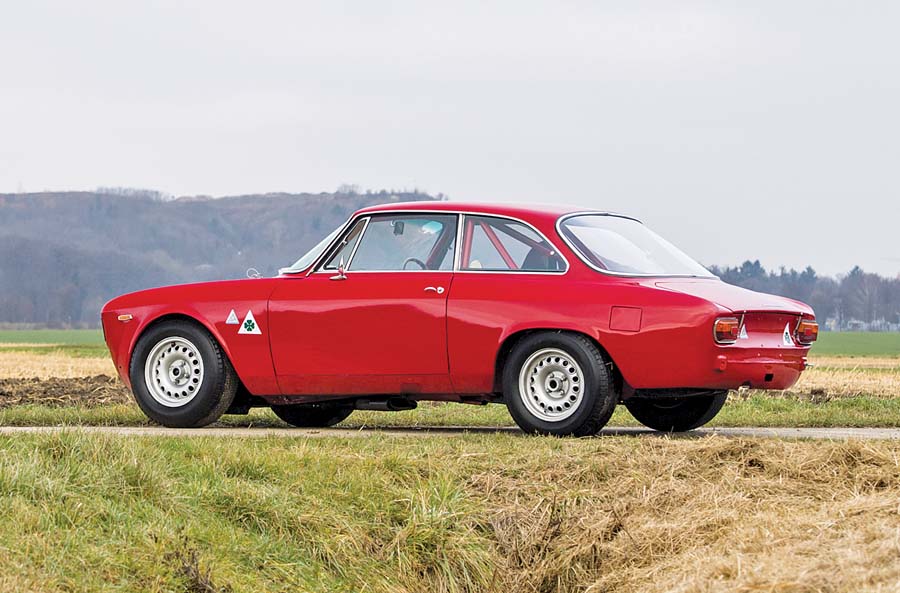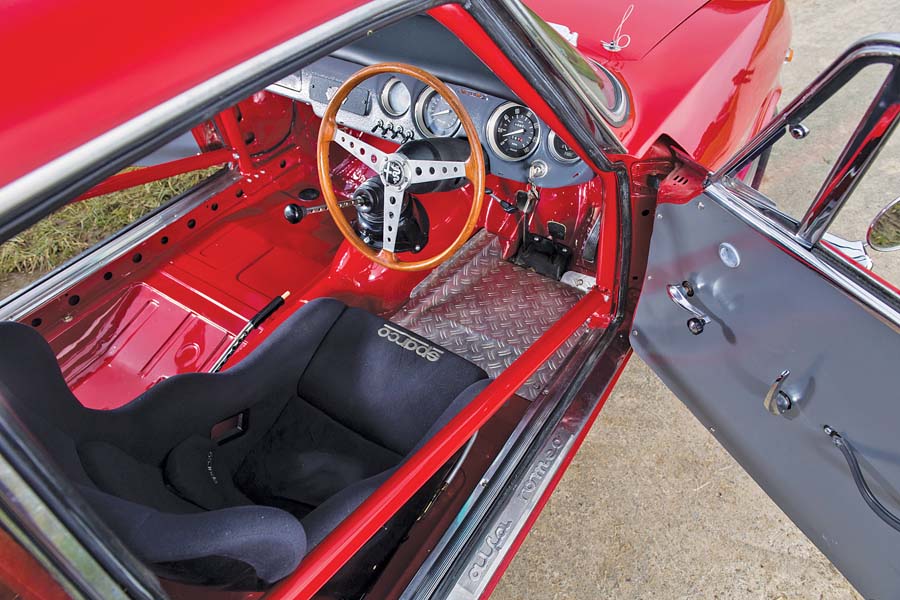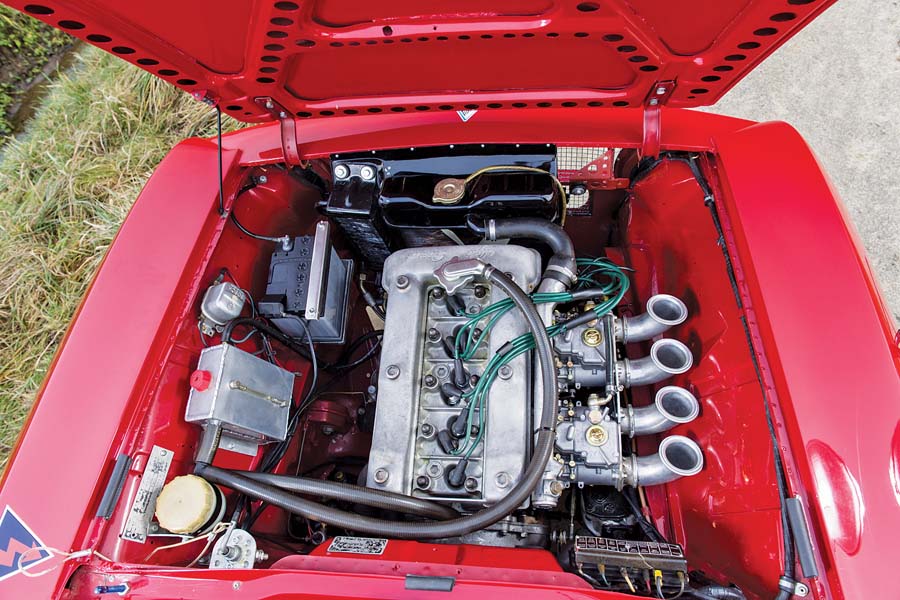SCM Analysis
Detailing
| Vehicle: | 1965 Alfa Romeo Giulia Sprint GTA |
| Years Produced: | 1965–67 |
| Number Produced: | 560 |
| Original List Price: | The Stradale was about $7,000. The Corsa was about $12,000, depending on options |
| SCM Valuation: | Stradale at $283,000, Corsa at $467,000 |
| Chassis Number Location: | On firewall above right cam |
| Engine Number Location: | On block below front carburetor |
| Club Info: | Alfa Romeo Owners Club |
| Website: | http://www.aroc-usa.org |
| Alternatives: | 1962–66 Lotus Cortina, 1968–71 BMW 2002, 1962–64 Mini Cooper |
| Investment Grade: | A (Corsa) |
This car, Lot 127, sold for $282,139, including buyer’s commission, at RM Sotheby’s Villa Erba auction in Italy on May 27, 2017.
The 1960s were a pretty good time for Alfa Romeo. With the introduction of the 1,600-cc Giulia in 1962, they were able to ramp up production while improving both initial quality and reliability, and their cars were selling well.
From a competition standpoint, 1963 saw the introduction of the Giulia Tubolare Zagato — also known as the TZ. It was Alfa’s first purely competition car since the early 1950s (although they did build “Stradale” road versions, nobody was fooled), and it quickly proved to be a giant-killer.
In the early times their Giulia TI sedan was quite competitive in the very important “win on Sunday, sell on Monday” Touring Car Championships, but that crown was insecure. Ford had introduced the Lotus Cortina, which, with its Lotus twin-cam engine and substantially lighter weight, was proving troublesome.
Alfa needed something quicker.
Hello, Sprint GTA
With the introduction of the Giulia series, Alfa had replaced the venerable Giulietta Sprint coupe with an all-new design from Bertone designer Giorgetto Guigiaro named the Giulia Sprint GT.
It was a stunning design for its time, simple and clean. Technically, it is a 2-door, 4-seat sedan — I recall one magazine describing the rear seats as “perfect for two legless 12-year-olds.”
But the Sprint GT was really a wonderful two-person GT coupe. It was the perfect candidate for a production touring car racer, but at 2,200 pounds, it was way too heavy. To resolve that, Alfa created a “homologation special” production GT to be called the GTA (Alleggerita, or “lightened”). They had to build 500 examples to meet the rules.
The Giulia GT used a unibody construction approach, with an internal stamped and welded sheet-metal substructure welded to the steel body panels to create a rigid chassis.
Fortunately, the internal structure was strong enough on its own to carry the loads, so Alfa created the GTA by pop-riveting and bonding aluminum body panels onto the core instead of welding the steel ones.
Alfa was relentless about reducing weight, particularly on the competition Corsa examples. The rear and side windows were plastic, the seats were ultra-lightweight, most of the cast-metal bits were magnesium instead of aluminum and there was no sound insulation. They even tried using aluminum floor pans, but it hurt the chassis stiffness too much.
A full-pop racing Corsa weighed 1,640 pounds — 450 pounds less than a stock GT.
A Hemi tuned for racing
The engine was the other serious change. While developing the TZ2 for the 1965 season, Alfa designed a twin-plug cylinder head.
Hemispherical combustion chambers were all the rage in the 1950s and early 1960s because they allowed big, canted valves with straight-port routing — but they had an inherent problem.
Getting high compression required a very big dome on the piston to fill the chamber, and that in turn meant a very long flame path from a center spark plug. This was fine until the RPM got above 6,500 or so, at which point the flame couldn’t keep up with the piston and efficiency dropped off.
The simple solution was to use two spark plugs located towards the outsides of the chamber, which had the additional advantage of allowing larger valves. The engine also got larger carburetors — 45 DCO Webers — instead of the stock 40s.
None of this mattered very much for the street GTAs. Listed horsepower for a GTA was 133 vs. 126 for a stock GT, but it mattered a bunch when the race tuners started doing their job. A reliable 175 horsepower — or more — at 7,800 rpm was relatively attainable. This engine, placed in a 1,650-pound car, makes a formidable racer.
Racers vs. street cars
As with any homologation special, the street version was a pale imitation of the fire-breathing full racers.
Autodelta was the racing department, with a separate factory. The factory racing versions were Stradales built at Alfa and then sent to Autodelta, where they were taken apart and reassembled as Corsas to whatever specification the customer wanted.
The available parts were amazing: magnesium transmission casings, oil pans, differential housings — even valve covers.
Transmission internals ranged from close-ratio synchro to Colotti dog-engaged gears. The infamous “sliding block” rear suspension was great for the track, but you’d never want one on the street.
All of this didn’t come cheap: A full race Autodelta Corsa GTA cost about 6 million lira, twice the price of a Stradale and about the same as a new Ferrari 275 GTB.
They were bloody fast, though.
The car to beat
Introduced in late 1965, the GTA was the car to beat in the European Touring Car Championships and American Trans-Am for 1966 and 1967. Because the factory Corsa was a spendy approach — and Autodelta was perfectly happy to sell various racing parts directly — lots of customers chose to buy Stradales and turn them into racers with a combination of Autodelta and outside components. This was true in the era and later in the historic period.
The true, certified Autodelta Corsas are very rare and are much more highly valued than competition-converted Stradales, which are more valuable than street Stradales.
Why so inexpensive?
Our subject car presents a bit of a conundrum in figuring out what it really is. The catalog copy artfully avoids describing the car as a Corsa, even though it apparently went directly from the showroom to the racetrack, has multiple important Autodelta parts, and Conrero was a serious racing team.
I would guess that it is a converted Stradale, which would shed some light on why it sold for what it did. Mark Leonard of Grand Prix Classics knows GTAs very well, and he tells me that good race- converted Stradales sell now for $300,000–$350,000, while the best Corsas with history are easily $400,000–$450,000.
Why then did this car, which appears to have been beautifully restored and has good period history, sell for only $283,500?
The short answer is that I don’t know.
Since many GTAs in Europe are used in road events like Tour Auto as much as track raced, the fact that it is a right-hand-drive car (thus more difficult to drive in European traffic) might have hurt its value.
There may have been some unmentioned defect or problem with the car, although RM Sotheby’s is highly reputable and the catalog speaks highly of the body’s originality.
It is unlikely that the engine is original, as there is a note of a blown engine in the history, but this is hardly unusual in serious racers.
The car may have slipped under the Alfisti racer radar. Villa Erba is a smaller venue when it comes to auctions, and possibly few people knew the car was coming up for sale.
Whatever the cause, the car sold for substantially less than I or a number of people I discussed this with would have expected. I would say very well bought, indeed. ♦
(Introductory description courtesy of RM Sotheby’s.)



